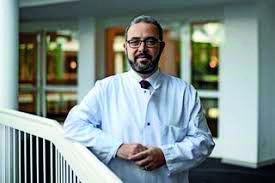
A “minimalist” transcatheter aortic valve implantation (TAVI) strategy—using local anaesthesia without sedation—has been shown to be non-inferior to a standard approach involving sedation for a composite primary endpoint of cardiovascular events and complications at 30 days.
This is the headline finding of the DOUBLE-CHOICE trial, an investigator-initiated, open-label, 2×2 factorial randomised trial, conducted at 10 centres in Germany, in which investigators assessed the two approaches in more than 750 patients. Results were presented as late-breaking data at the 2025 European Society of Cardiology (ESC) congress (29 August–1 September, Madrid, Spain).
“Minimalist treatment strategies for TAVI—such as using local anaesthesia without sedation—have been widely adopted due to continued procedural evolution. However, large, randomised trials comparing the minimalist approach with the standard of care have not been performed,” investigator Mohamed Abdel-Wahab (Heart Center Leipzig at Leipzig University, Leipzig, Germany) said of the research. “Furthermore, while several head-to-head trials of different TAVI devices have been conducted, comparisons are lacking between different contemporary self-expanding devices in patients with well-defined anatomy.”
The study included patients with severe, symptomatic aortic stenosis, who were indicated for TAVI, and whose anatomy was considered suitable for the procedure using either the Evolut Pro, Pro+ or FX (Medtronic) or the now discontinued Acurate neo2 valve platforms.
Patients were randomised either to undergo a minimalist procedure, which included isolated local anaesthesia with no sedation, central venous lines, additional arterial lines for blood pressure monitoring, or urinary catheters. Patients in the standard anaesthesia group were sedated with continuous CO2 monitoring, supplemental oxygen and the use of central venous catheters, additional arterial lines and urinary catheters according to local practice.
The trial’s primary combined endpoint at 30 days included all-cause mortality, vascular and bleeding complications, infections requiring antibiotic treatment and neurologic events. The use of the two device platforms was also compared with a primary 30-day combined endpoint that included all-cause mortality, stroke, moderate or severe prosthetic valve regurgitation, and permanent pacemaker implant.
The 752 patients in the intention-to-treat anaesthesia comparison had a median age of 83 years and almost 60% were women. The primary combined endpoint at 30 days occurred in numerically fewer patients with minimalist vs. standard care: 22.9% vs. 25.8%. Around 19% of patients crossed over to the standard-care group, mostly due to pain or discomfort.
In per-protocol and as-treated analyses, the difference in favour of the minimalist approach was more pronounced and statistically significant in the as-treated analysis, Abdel-Wahab detailed.
Across 855 patients in the device comparison, the primary combined endpoint at 30 days occurred in 15.4% of patients with Acurate neo2 valve and 30.4% with Evolut valves, a difference that was mainly driven by lower pacemaker implantation in the Acurate group—11.2% vs. 26.5%, respectively.
“Our results indicate that around 80% of patients can be safely managed with the minimalist approach,” Abdel-Wahab said of the results. “Further analyses may help to better inform in which subgroups the minimalist approach is most or least suitable.
“Regarding devices, we found that Acurate neo2 valves were superior to Evolut valves in our trial, which was conducted by highly experienced operators with careful patient selection. Acurate neo2 valves have since been withdrawn, but reductions in pacemaker implantation observed with these devices indicate that aspects of their design could be used to inform future valve development.”










